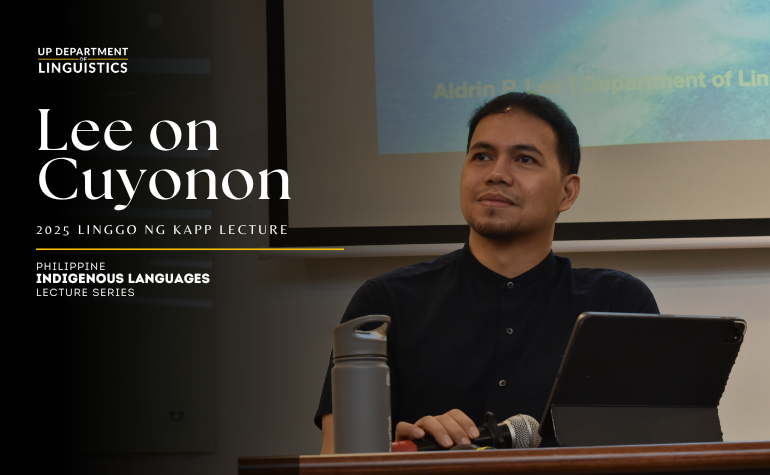
In this Faculty Spotlight, Ann-sensei, Ria-sensei, and Farah-sensei share their origin stories, teaching experience at UP Diliman, and tips for learning nihongo. Get to know the first set of our featured Japanese language teachers!
What got you interested in learning and teaching Japanese?
Ma’am Ann: When I was asked to choose a plan during my undergraduate studies in Linguistics, I decisively chose Japanese because I was drawn to the challenge of learning a language that was largely unfamiliar to me. What particularly intrigued me about learning Japanese was the characters (hiragana, katakana, kanji). I find it fascinating to explore a foreign writing system and discern the differences in linguistic structure between Japanese and my native language. I derive fulfillment from imparting knowledge about the structural differences between Filipino and Japanese languages to my students.
Ma’am Ria: Kumuha ako ng Japanese noong college kasi eto yung meron sa dept. Hindi ko kailangang pumila para sa slot. Yung mga members din ng SALIN na nag-invite sa batch namin, halos lahat sila Plan C, kaya marami kaming naririnig na kuwento from them. Hindi naman ako mahilig noon sa anime, pero nagka-ayaan na lang kami ng ilang blockmates na kumuha ng Japanese tapos nagtuloy na rin kami sa Plan C.
Bago ako gumradweyt, natanggap ako sa isang student exchange program. Doon nagsimula ang interes ko sa anime, movies, variety shows, artista, etc. Dahil din sa exchange program, nag-improve ang Japanese ko. Bata pa lang ako, inisip ko talaga na magtuturo ako (not necessarily sa Lingg). Naimbitahan kaming magturo sa department at dahil marunong akong mag-Jap, kasama siya sa mga tinuturo ko.
Ma’am Farah: I started studying Japanese around 2 years before the initial Pokemon craze in the Philippines — hindi pa in-demand ang Japanese kaya madaling i-enlist. I wasn’t really interested in the language, it was more because of convenience and also curiosity if it is similar to Chinese. My interest in the language grew as I studied it more. And studying Japanese got me interested in linguistics.
Teaching Japanese wasn’t also part of the “plan”. Nagkataon lang na nag-MA ako sa linguistics, nagturo dito eventually, at nagturo na rin ng languages na alam ko.
Teaching Japanese got me interested more in the language and also the culture and society.
How is your experience teaching the language at UP Diliman so far?
Ma’am Ann: Teaching the Japanese language is an enriching journey that brings a sense of fulfillment, excitement, and occasional challenges. As I teach, I also learn from my students, which deepens my understanding of the language and each student’s unique qualities. This reciprocal learning process has helped me appreciate and understand the diverse backgrounds and learning styles of my students, allowing me to tailor my teaching methods to better meet their individual needs.
Ma’am Ria: So far? 20 years na rin. Nagsimula ako noong 2003. Hindi pa ako gumagamit ng ppt. Picture cards at flash cards pa ang gamit ko. Sulat sa board. Ang daming papel! Cassette tapes pa ang gamit para sa listening exercises!
Standard naman ang content ng bawat Japanese subject pero puwede kami mag-explore ng mga activities na gagamitin sa klase. Kaya naman masaya. Naipapasok ko rin ang mga interes, as materials, activities or content mismo sa klase. Hindi malayo na maging close ang mga estudyante (minsan kasama na rin ang teacher) kasi ang dami-daming naishe-share na personal (minsan too personal) in the name of class activities. Nakakabata ang pagtuturo ng wika. Hindi lang ako yung may itinuturo sa klase. Mas marami akong natutunan from my students.
Ma’am Farah: I’ve had good times and bad times. Japanese has become a popular language course when I started teaching at the Department — at a time na 3-4 lang kaming nagha-handle ng Japanese, tapos yung iba sa amin nagtuturo din ng Linguistics. May times na more than 30 ang estudyante ko. Back then, wala pa akong masyadong alam na iba’t ibang teaching styles and approaches kaya masyado akong grammar-centric, traditional, at teacher-centered.
Dahil na rin siguro sanay tayo sa teacher-centered approach, may students na sobrang dependent sa klase for their learning, thinking na basta’t nag-attend sila ng klase e gagaling sila sa Japanese. This, until now, I find very disappointing.
What I like about teaching in UP is the relative freedom we have in working around the syllabus, experimenting on new teaching styles and classroom activities, and using teaching materials other than the agreed-upon textbook. Nagsasawa ako pag paulit-ulit yung tinuturo ko so I would use whatever I’m interested in into my classes, e.g., mga pinapanood kong drama, variety shows, movies; manga, social media posts, commercials — lahat na mahanap ko ng connection sa lessons namin. My classes also served as catalyst during some hard times. I would incorporate songs, poetry, novels, and artworks that helped me ease some of my worries and emotions into my classes.
Yung isa ko pang gusto, about teaching in general, is the continuity of learning.
Marami akong natututunan sa students ko, colleagues, iba’t ibang activities na, in turn, naibabahagi ko sa susunod kong mga estudyante, and the cycle goes on.
Can you share some tips for learning Japanese, especially for students who might be intimidated by the language and its writing system?
Ma’am Ann: As the saying goes, “practice makes progress.” Your skills doesn’t necessarily have to be perfect right away, what’s important is you are making progress. Just keep practicing. I learned Japanese through music, diligently listening, writing down unfamiliar words, and looking up their meanings. This process improved my listening skills, expanded my vocabulary, and enhanced my grasp of grammar. Watching Japanese dramas/movies/anime is a good way to practice your Japanese skills too. Immersing myself in Japanese dramas further improved my understanding of grammar and the practical usage of words in casual Japanese conversations. In the past, we were limited to practicing Japanese within the classroom. Now, with advanced technology, there are countless resources available to help you improve your Japanese skills. Embrace these resources and, most importantly, enjoy the learning journey!
Ma’am Ria: Huwag sila masyadong matakot sa writing system. Mas marami pang challenging aspects sa Japanese language learning. Tips for learning: Isama niyo lang ang nihongo sa araw-araw niyong buhay. Kung gustong maging proficient, maging bread and butter in the future, simulan na kahit small steps. Maghanap din kayo ng kasama mag-aral, para may practice buddy na kayo agad. Piliin niyo lang kung ano ang swak sa inyong personality.
Ma’am Farah: Dapat o sana alam natin kung bakit tayo nag-aaral. Mahirap kasi we see education as one of those stuff that we’re supposed to do and we just do as we’re told. Pag alam natin kung bakit o para saan tayo nag-aaral, mas magiging malinaw sa atin kung paano tayo mag-aaral.
If your objective is to pass a class or the JLPT, then study for the class or the JLPT. Kung hindi naman, think about your motivation for learning.
Halimbawa ako, I never thought of and have no plans of working in Japan or for a Japanese company. I studied and continue to study Japanese for personal reasons — to understand Japanese comedy; to learn about social issues; and to know more about the intricacies of the Japanese language. Sa Japanese comedy, for example, may reference sila sa pop culture like Totoro and Anpanman, current events like political scandals, and some inside jokes in the industry. Yung iba naman gumagamit ng regional dialects. So to better appreciate Japanese comedy, I need to understand all these on top of knowing the language.
We should also be aware of how we best learn things or yung kanya-kanya nating learning styles. Hindi ako magaling mag-memorize. I’d rather learn vocabulary, pronunciation, reading and meaning of characters in context. To connect that with my previous point, imbis na textbook, nagbabasa or nanonood ako ng recipe or travel guide in Japanese.
Published by UP Department of Linguistics



